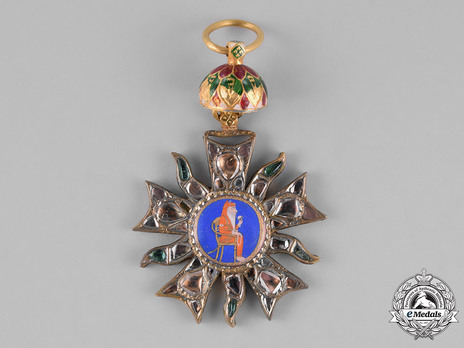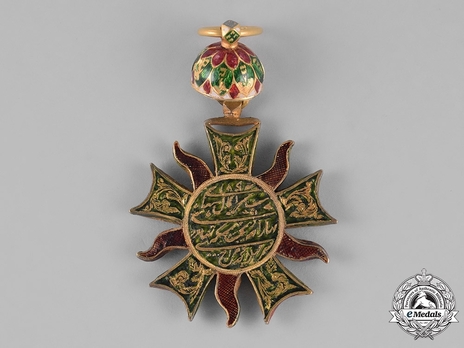Order of the Propitious Star of Punjab, II Class Badge
CATEGORY: Version
SKU: 01.IND.0136.102.01.000
Estimated market value:


Estimated market value:
(Auspicious Star of the Punjab). (Star of the Prosperity of the Punjab). (Kaukab-i-Iqbal-i-Punjab). Instituted by Maharaja Ranjit Singh, Sher-i-Punjab in 1837. Inspired by medals and awards worn by visiting Europeans at the court of Ranjit Singh in the 1830's, the Propitious Star of Punjab is both rare and desirable. In solid Gold, consisting of five broad arms inlaid with five early free formed sectional diamonds and with a crescent finial, with an organic shaped ray in each quadrant composed of a principle diamond and tipped with a brilliant green emerald, obverse centre presenting Maharaja Ranjit Singh seated at his court, hand painted on enamel with Gold surround, reverse entirely hand engraved with arms presenting a floral motif and rays with a checkered pattern, with red and green rudimentary enameling, reverse centre with etched Punjabi script, with ornate enameled flowered bell shaped suspension connected to award by Gold wire and a horizontally pierced integral suspension, measuring 53 mm (w) x 78 mm (h - inclusive of bell suspension), 57.8 grams, worn with minor enamel loss, remains very fine.
This Order may have been conferred in commemoration of the marriage of Nau Nihal Singh, Ranjit Singh's grandson; however, this is inconclusive.
This Order may have been conferred in commemoration of the marriage of Nau Nihal Singh, Ranjit Singh's grandson; however, this is inconclusive. Several sources have attributed it to being founded in 1837.
One source, Fauja Singh Bajwa, refers to this decoration in being in three classes denoted by the precious stones involved. I Class had diamonds, while the II Class had diamonds and emeralds, and the III Class, just emeralds. All three classes feature an image of the Ranjit Singh on the obverse and his name on the reverse. However, numerous examples have been seen in differing designs. For example, one had a flower design on the reverse.
According to Fauja Singh Bajwa, the rules regarding the awarding of this decoration were created by Captain C.M Wade, Politcial Agent, Ludhiana and amended by Sir Henry Fane.
The I Class was to be awarded to the royal family, foreign princes and distinguished chiefs who were allies of Ranjit Singh.
The II Class was to be wawarded for courtiers, sardars, governors of provinces, general officers and envoys. This class carried the title of Sardar.
The III Class ws awarded to officers of the rank of Captain to Colonel and deserving civil funcitonaries. The military class was separate from the civil class in the recorded degree of merit. An officer who distinguished himself in one action would recieve the star; the second or third actions whould be recognized by clasps from which the star would be suspended. Each clasp bearing the name of the action. A fourth action would result in a gold cross to be worn above the cross. However, it is completely unknown how these clasps would be worn. This class carried the title of Bahadur.
There is limited information regarding this item.

Comments
Sign in to comment and reply.


Scroll Top